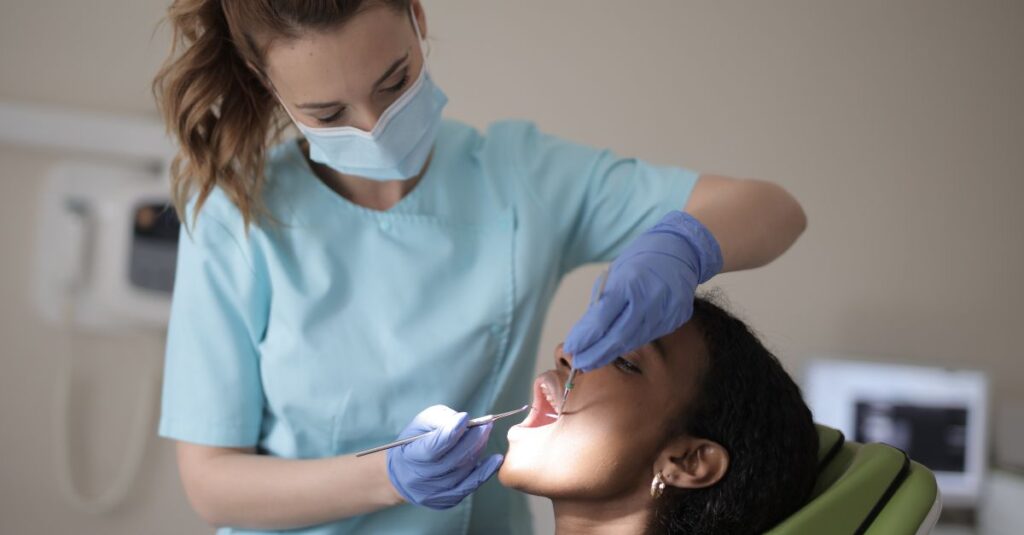As a long-term, repeat patient at Keppel Dental, you’ll get to know all of our staff. Supporting you with optimal oral health care is a team effort. And there are members of our team you may see as much—if not more—than your dentist. Our oral health therapists (OHTs.)
Until you settle into a care routine with us, you might not be clear about the difference between an OHT and a dentist. When should you see one and not the other? And, if we’re honest, there are many myths and misconceptions about who an OHT can treat.
To help you decide if you need to see a dentist or an OHT, here’s a guide to what they do and the part they can play in your care plan.

The quickest OHT job description you’ll ever read
It’s a common misconception that OHTs only treat children and young people. An oral health therapist can complete a degree that qualifies them to treat people up to age 18. However, most OHTs choose ‘adult scope’ training which allows them to treat everyone.
Their focus is promoting good oral hygiene practices. So they spend a lot of time walking patients through a personalised cleaning routine that fits their lifestyle. However, they’re also qualified to carry out preventative and restorative dental treatments for people of all ages.
An oral health therapist (OHT) can treat children, teenagers and adults. It’s a myth that OHTs can only treat children and young people.
Becoming an OHT
OHTs in Australia must complete a three-year university bachelor’s degree in dental hygiene and dental therapy. Generally, having an interest in biology and chemistry helps, with Australian universities requesting Year 12 High School Certificates (HSC) in these subjects.
Getting on to an OHT course is competitive. To demonstrate their commitment, prospective OHTs may complete certificates in dental assisting before applying for a university course. Even then, a place isn’t guaranteed as an applicant still needs to pass an entry exam.
Qualified OHTs must register with the Australian Health Practitioners Registration Association (AHPRA) and the Australian Dental Board. These bodies provide ongoing professional development to ensure the OHT’s knowledge and skills stay up to date.
With the I’s dotted and T’s crossed, a qualified OHT can then apply for a dental practice job and start treating patients.
What treatments can an OHT carry out?
When you’re experiencing any discomfort in your teeth and gums, or have oral health concerns, it’s best to see a dental clinician as quickly as possible. Knowing which treatments an OHT can carry out will help you decide if you need to see a dentist, or your needs can be met by scheduling an appointment with an OHT.
You might see an OHT for:
- teeth whitening
- a comprehensive oral exam
- advice on oral health care and cleaning
- a filling or preventative restorative treatment such as a fissure sealant
- a maintenance clean and polish or non-surgical periodontal treatment
- x-rays and diagnostic tests. This may include:
- Bitewing and Periapical radiographs
- OPG and CBCT radiographs
- diagnosing gum disease, the vitality of the tooth, or if a tooth infection is present.
An OHT can also extract baby teeth under local anaesthetic, and diagnose some oral diseases such as gingivitis and periodontitis. Depending on the severity of the periodontal disease, an OHT may also carry out treatment, including deep cleaning (or debridement) and helping patients establish a healthy at-home oral care routine.
However, you’ll be referred to a dentist if the periodontal disease has progressed to a point where you need surgical gum disease treatment, such as a gum graft.
The difference between an OHT and…
A dentist, OHT and oral hygienist can perform many of the same day-to-day dental therapy services. So, who can do what and when?. Let’s clear that up by looking at the differences between an OHT and a dentist, and an OHT and an oral hygienist.
…a dentist
Qualified dentists hold a Bachelor of Dentistry—a 4-5-year university course, as opposed to three. Dentists can diagnose and treat all oral health conditions and carry out treatments such as dental implants, dental crowns, and adult tooth extractions.
For any treatments they don’t provide, your dentist can assess and refer you to a dental specialist (such as an oral surgeon and orthodontist).
…and an oral hygienist
Like OHTs, an oral hygienist must complete a three-year bachelor’s degree. The roles are similar in many respects. They can both:
- treat patients of all ages
- assess, diagnose and treat periodontal and gum disease
- educate in and encourage healthy oral care habits.
Unlike oral hygienists, OHTs can also:
- do fillings
- remove teeth
- whiten teeth
- carry out diagnostic tests and take x-rays
- provide other restorative treatments such as a fissure sealant.
Ready to make an appointment?
Knowing which services an OHT can provide gives you confidence when booking your appointment. And better yet, wait times for seeing an OHT may be much shorter than for seeing a dentist, meaning you can get your checkup done and dusted sooner.
If you’re in the Yepoon and Rockhampton area and would like to get your teeth checked by a Keppel Dental OHT get in touch.
Contact
"*" indicates required fields